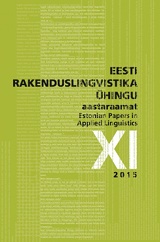Eesti ja soome keele vastastikune mõistmine üksiksõna- ja tekstitasandil:
Mutual intelligibility of estonian and
finnish context-free words and texts:
Linguistic determinants, comprehension process and symmetry
Author(s): Annekatrin KaivapaluSubject(s): Theoretical Linguistics, Comparative Linguistics
Published by: Eesti Rakenduslingvistika Ühing (ERÜ)
Keywords: receptive multilingualism; perceived cross-linguistic similarity; Estonian; Finnish
Summary/Abstract: The paper deals with the mutual intelligibility of written Estonian and Finnish on two levels: on the level of individual context-free words and on the level of a text as a whole. The study aims to explain whether and how Estonian speakers understand Finnish and Finnish speakers Estonian with no previous formal learning or exposure to the closely related target language, and how the comprehension of individual context-free words differs from the comprehension of a text. The results of the comprehension tests and the participants’ comments on their process of understanding are discussed to shed light on the possible symmetry of mutual intelligibility and on the linguistic determinants having an impact on the comprehension process. The discussion is followed by proposing a model of intelligibility. According to the test results, the Estonian-speaking participants were more successful in comprehending context-free words, particularly the words with similar meaning and similar spelling, as well as loanwords. Finnish-speaking participants succeeded better in comprehending the whole text. Perceived cross-linguistic similarity has a crucial role in comprehending both of the target languages: the base of understanding is finding similarities between Estonian and Finnish, as well as other previously learned languages and the target language. Those similarities are combined with metalinguistic and general knowledge and the assumptions made are checked in the context of a sentence, a paragraph and a text. Context operates as a kind of filter, either confirming or disproving the assumptions made. The distribution and order of use of the components of the understanding process vary from person to person and largely depend on the participants’ previous knowledge and experience.
Journal: Eesti Rakenduslingvistika Ühingu aastaraamat
- Issue Year: 2015
- Issue No: 11
- Page Range: 55-74
- Page Count: 20
- Language: Estonian

